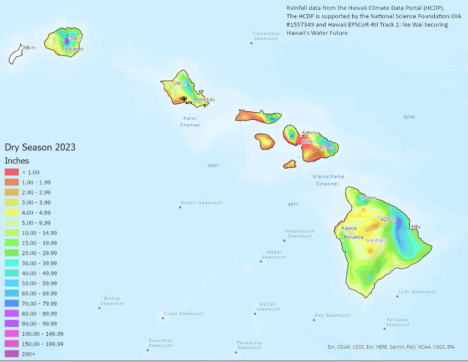Below Average Rainfall Predicted for Wet Season
By Jack Kiyonaga | Editor

Photo courtesy of National Weather Service.
Unfortunately, it sounds like the upcoming wet season will be unseasonably dry. According to Kevin Kodama, hydrologist for the National Ocean and Atmospheric Administration (NOAA), below average rainfall is expected throughout the state.
For Molokai specifically, Kodama is likewise predicting a drier than normal winter.
“I’m fully expecting drought conditions on Molokai to worsen from what you’re seeing now,” explained Kodama.
The reason for the expected worse-than-average rainfall is due to the El Nino weather pattern, which developed late last spring.
El Nino is a warm weather anomaly caused by hotter ocean temperatures which results in less rainfall for certain areas. This year’s El Nino is predicted to continue into the spring of 2024.
The current El Nino is anticipated to be a “strong event” with about a 30 percent chance of developing into a “historically strong” event, like those witnessed in 1998 and 2016.
According to the U.S. Drought Monitor, Molokai currently exhibits signs of drought across the island. The categorization of drought currently ranges from D0, abnormally dry, on the east end and to D2, severe drought, on the west.
“Conditions are just expected to get worse,” said Kodama.
According to Kodama, he expects the west end of Molokai to end up in D2, severe drought, or D3, extreme drought, as consistent with previous El Nino seasons.
Kodama predicted that the most affected areas due to rainfall deficits would be agriculture and water supply, along with an increased risk of brush fire and red flag days.
One positive effect of the El Nino is that the likelihood of damagingly heavy rains, like those seen last January, are less likely to occur.
In terms of preparing for the drier winter, Kadoma explained that “the main thing would be to conserve now to mitigate having restrictions declared.”
Kodama likewise cautioned that the “State Dept. of Agriculture may add restrictions to water use for those on their irrigation system.”
Maui County’s Dept. of Water Supply Conservation page outlining methods of conserving water can be found at waterresources.mauicounty.gov/153/ Water-Conservation.











Don't have a Molokai Dispatch ID?
Sign up is easy. Sign up now
You must login to post a comment.
Lost Password